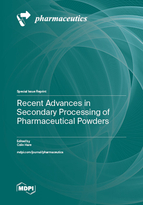Recent Advances in Secondary Processing of Pharmaceutical Powders
A special issue of Pharmaceutics (ISSN 1999-4923). This special issue belongs to the section "Pharmaceutical Technology, Manufacturing and Devices".
Deadline for manuscript submissions: closed (31 March 2023) | Viewed by 33580
Special Issue Editor
Special Issue Information
Dear Colleagues,
Following their formation, Active Pharmaceutical Ingredients (APIs) undergo several process steps to form a solid dosage form, such as milling, mixing/blending, granulation, die-filling and tabletting. Although the overall process has been around for many years, challenges remain for each of these unit operations in terms of design, control and optimisation. Additionally, there is a drive towards continuous pharmaceutical manufacturing, which brings its own set of novel challenges. This Special Issue: "Recent Advances in Secondary Processing of Pharmaceutical Powders" aims to highlight the state of the art in all aspects of pharmaceutical production that follow crystallisation, including the processing of excipients.
Dr. Colin Hare
Guest Editor
Manuscript Submission Information
Manuscripts should be submitted online at www.mdpi.com by registering and logging in to this website. Once you are registered, click here to go to the submission form. Manuscripts can be submitted until the deadline. All submissions that pass pre-check are peer-reviewed. Accepted papers will be published continuously in the journal (as soon as accepted) and will be listed together on the special issue website. Research articles, review articles as well as short communications are invited. For planned papers, a title and short abstract (about 100 words) can be sent to the Editorial Office for announcement on this website.
Submitted manuscripts should not have been published previously, nor be under consideration for publication elsewhere (except conference proceedings papers). All manuscripts are thoroughly refereed through a single-blind peer-review process. A guide for authors and other relevant information for submission of manuscripts is available on the Instructions for Authors page. Pharmaceutics is an international peer-reviewed open access monthly journal published by MDPI.
Please visit the Instructions for Authors page before submitting a manuscript. The Article Processing Charge (APC) for publication in this open access journal is 2900 CHF (Swiss Francs). Submitted papers should be well formatted and use good English. Authors may use MDPI's English editing service prior to publication or during author revisions.
Keywords
- pharmaceutical manufacturing
- particle breakage
- milling
- powder mixing
- powder blending
- granulation
- die filling
- tabletting







